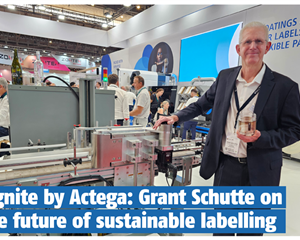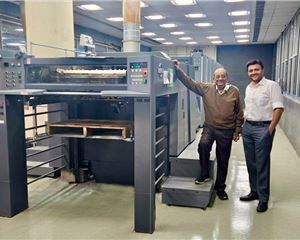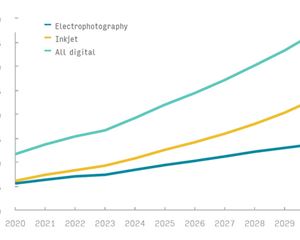Times Group production plant at Sahibabad, UP
Two million copies per day and counting
23 Jul 2015 | By Rahul Kumar & Dibyajyoti Sarma
How does India’s largest selling newspaper keep itself ahead of its competition? Rahul Kumar and Dibyajyoti Sarma look for answers at the shopfloor of the Times Group production plant at Sahibabad in Uttar Pradesh.
As we are given a conducted tour of the printing facility of the Times Group, located at Sahibabad Industrial Area in Ghaziabad, UP, what strikes us is how spick and span the shopfloor looks. After all, this is a newspaper printing facility. You expect discarded newsprints strewn around; you expect random confusion. Instead, we are led through almost empty corridors to the wheezing sound of the machines at work. It is a weekday afternoon and the workload has not started piling up. As we walk by a towering machine, with our guide giving us the specifications, with the same genial demeanour of a tour guide, we see various advisory notices on the wall, telling the workers, both in Hindi and in English, to be careful and not to get hurt, and to wear earplugs while on the shopfloor.

There are other notices as well, including the work ethics of Bennett, Coleman & Co, the publishers of the flagship The Times of India (TOI), the world’s highest circulated English daily, and also the publishers of The Economic Times, Nav Bharat Times and others.
There is also an ‘innovation alley’, which displays the past TOI issues featuring innovations, such as French windows, glued-on half covers, and butterfly covers, among others. We also notice a number of boards featuring graphs and charts about the performance of the machines and the human contribution to it. There is also a board displaying quality.
In its initial days, the newspaper house had the printing facility on the basement of its editorial office located at the Bahadur Shah Zafar Marg, New Delhi. Later, the printing facility was shifted to 15/1 Sahibabad. The machines at this facility were mostly single-width, and the production capacity was low. As the production went up, the current facility was set up in 1997, with a series of Manroland presses. The older facility, with mostly India-made Manugraph machines, is still working, though the main editions are not printed there.
Manroland loyalty

The first machine installed at the new site was a four-tower Geoman, a 4x2 shafted press. A second Geoman was installed in 2002. It is a shaftless press with five towers, which can print 20 colour pages double out. In 2007, the company got its first Colorman, with eight-tower, twin-balloon folder. A second Colorman was installed in 2009. It is also an eight-tower press, but the configuration is slightly different. It is a spilt press, which can print two different products at the same time.
How does this split press work?
Sudeep Bhattacharjee, assistant vice-president, production, the Times of India Group, explains. “For example, we can print both The Times of India and The Economic Times at the machine at the same time. It has two different operating consoles and it can be treated as two different presses. Here, you can run one product two up and two different products one up. Also, one press can run independent of the other. You can stop one press and keep on running the other, which is not possible in other presses,” Bhattacharjee says.
Using technology
The company has five lines of Krause CTPs. The company has also shifted from AM screening to FM screening for ink optimisation. For this, the company invested in a software called Binuscan. “It is an ink optimisation software, which replaces expensive CYMK with black,” says Bhattacharjee, adding that while the software is not the same as GCR, it is quite similar, but much more intelligent. This is because it looks at different pictures and analyses. “Our photographs pass through a certain profile. Then those files are created and they are printed,” he adds.
Image quality is another reason why the company shifted from AM to FM. “We went to FM looking at better depth of the pictures,” says Bhattacharjee. “In FM screening, you have proper control in pre-press and you get much better depth. Shadow details are very prominent in our photographs.”
Bhattacharjee explicates. “In analogue screening, you have the dot gain curve. This is no longer the case when you move to FM. You have no control on dot gain. It becomes as less as 19%. However, when you are in FM and ink optimisation, your CTP has to be well calibrated or tightly controlled,” he says. While not all brands of plates are conducive to FM, the company mostly uses TechNova places, which according to him, are very good.
Meanwhile, the mailroom facility of the plant boasts equipment from Ferag for the Colorman machines and equipment from Wamak for the Geoman.
Printing newspapers
There seems to be a debate going on about changing cut-off sizes. Bhattacharjee believes this is not an issue. “These days, newspaper ads sell on square centimetre, not on column sizes, as earlier. Now, it is directly proportionate to area. The new 533 mm presses have very narrow gap blankets, so they are actually getting the same print area as we are getting in 546 mm. This is okay. If you go for conventional blanket type, we will get much less area, which is not acceptable, as we will be losing out on revenue,” he adds.
The company was also an early adaptor of single-width presses. “Those were the Manugraph presses,” says Bhattacharjee. We have one such machine at the Sahibabad. The company invested in the last Manugraph in 2008.”
Now, apart from certain centres, such as Hyderabad, Ahmadabad, Lucknow and Nagpur, all the other TOI production plants have double-width with single circumference presses. Bhattacharjee adds that the Geoman variety of double width with double circumference is available only in Delhi and Mumbai. “Mumbai has two plants, in Kandivali and Airoli. Both put together is bigger than the Delhi plant. However, if you consider a single-location facility, the Sahibabad facility is the biggest,” he says.
Challenges of production

The first challenge, Bhattacharjee points out, is the newsprint quality. “Quality-wise, the local newsprint is far behind the imported ones. Even in case of imported newsprint, with more and more mills closing down, and production going down, the availability of quality newsprint is becoming a major issue. What we are getting these days are mostly the products from B or C class mills, which are just slightly better than the newsprint available in India. So, newsprint quality is a big issue,” he says.
When it comes to ink, Bhattacharjee says while we have all the ink multinationals in India, consistency in quality standards remains an issue.
Another major issue, when you consider the operations part of it, Bhattacharjee says, is that the ‘print window’ during the night is becoming shorter and shorter. Thus, press speed, the CTP, and everything else becomes important,” says Bhattacharjee. “Also, operation-wise, we are seeing more and more splits. The future belongs to splits.”
And, the total production capacity of the plant?
“If you consider just the four-and-a-half hours during the night, we are printing almost two million copies with different page numbers,” says Bhattacharjee.
“If you consider just the four-and-a-half hours during the night, we are printing almost two million copies with different page numbers,” says Bhattacharjee.
Best practices
Machines are fine. What is more important, however, is how these machines are being used. The plant here follows its own, home-grown system of best practices. “We have a concept called CIG, Continuous Improvement Group. These are small groups made up of the employees. We have them across all our plants. Each group works on different aspects of production, such as newsprint waste reduction, variable cost reduction, engineering spares, utility cost reduction, quality and so on,” says Bhattacharjee.

With this, Bhattacharjee says, the company has looked into all aspects of production. “We have actually changed our SOPs, gone into many improvement areas, reducing waste, reducing cost. This is our major advantage,” he adds.
This has also made the Times Group the only newspaper house to be certified by the DL Shah Quality Award, instituted by the Quality Council of India.
Innovations
The one thing that sets The Times of India apart from all other newspapers is the innovation. “In TOI, you see an innovation almost every day. We were the first people to start gluing newspapers in India. Apart from this, French window, panorama, super panorama, bookmark, we started all these innovations,” says Bhattacharjee.
The company’s gluing system is an apparatus which was designed and fabricated in-house. The company has a patent on it.
According to Bhattacharjee, innovation is the major differentiator. With innovations, the production department went from a cost function to a revenue function. All the innovations brought in special revenues. “We have ideation sessions across all plants, where we come up with the ideas. We look at different industries and see if something from there can be converted into print. For example, we looked at the fragrance industry and tried to put fragrance in the newspaper,” he adds.
The Times of India may have started the innovation in French Windows, but this innovation is now everywhere; the novelty is lost. “Today, technology is not like earlier,” says Bhattacharjee. “There is no trade secret. This is why we worked on how to differentiate from others. Buying a machine is not a solution. Others can too buy a machine. What you cannot buy is the brainpower. This is what we are trying to do, evolve and bring out new designs, which cannot be bought. Yes, it also is copied. Once it is in the market, others will learn how we have done it. But it gives us the first-mover advantage.”
The growth curve
In terms of growth, Bhattacharjee says, in the last three years, TOI has gone into almost every city in the country. More growth is coming from tier-two, tier-three cities. “In certain markets, where English is not predominant, we are also going regional,” he adds.
| Major innovations | |
| One of the major innovations in The Times of India was an advertisement by German carmaker Volkswagen for its entry level sedan, Vento, in 2010, where, in select cities, the newspaper came with a voice-recorded device pasted on it. |
| Bhattacharjee on PrintPack | |
| “I recently visited PrintPack 2015, where I was invited to speak at the conference. The exhibition was quite good. I saw enthusiasm all around. In the conference, I felt, people were not talking about how to reinvigorate the print industry. There was not much concern. There were lot of presentations, but ours was the only one that talked about how to look at innovation, how to increase revenue and how to follow a successful model.” |












 See All
See All